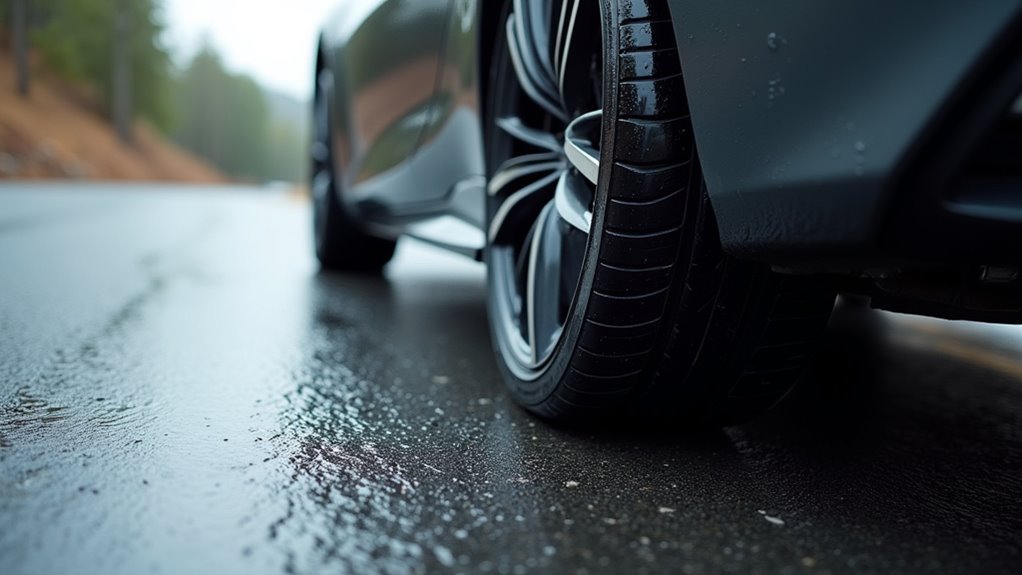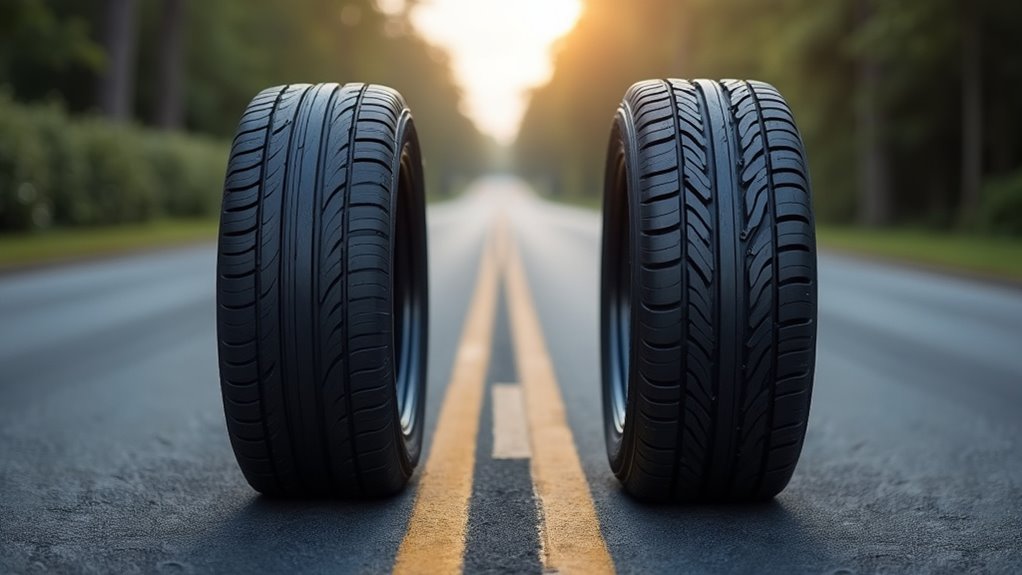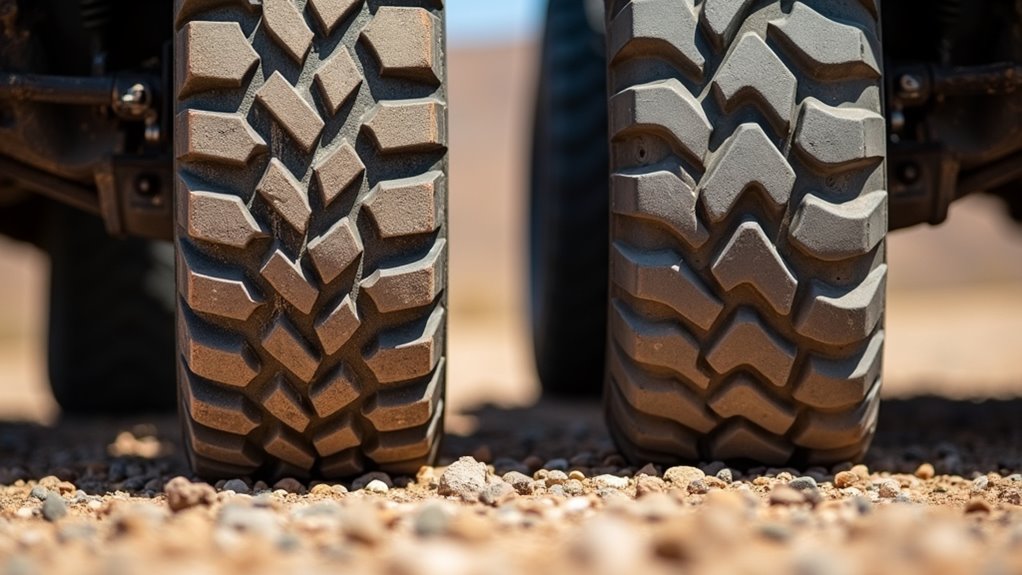Does Tire Width Matter
This post contains affiliate links. As an Amazon Associate, we earn from qualifying purchases.
Tire width significantly impacts your vehicle’s performance, safety, and efficiency. It influences factors like fuel economy, handling, and ride comfort, with narrower tires often offering better mileage and wider tires providing enhanced grip. For a deeper understanding of how to choose the ideal tire width, further details and explanations will follow in the article.
Essential Facts in 30 Seconds
- Tire width influences fuel efficiency, with narrower tires offering better mileage due to lower rolling resistance.
- Wider tires provide improved grip and stability, enhancing handling and cornering.
- Narrow tires with taller sidewalls deliver a smoother ride by better absorbing road bumps.
- Wider tires can increase road noise and vibration, reducing comfort.
- Proper tire width is crucial for safety, ensuring compatibility with vehicle load and speed.
Fuel Efficiency and Tire Width
Tires affect your car’s fuel efficiency in a big way. Their width matters a lot. Narrow tires help save gas with less rolling resistance. They touch less road, so the engine works less. This boosts your miles per gallon easily.
Wide tires drag more due to bigger contact. They need extra power, cutting down efficiency. Long highway trips show this difference clearly. Additionally, narrower tires often weigh less, which can further reduce fuel consumption. Wider tires also impact aerodynamics negatively, increasing fuel consumption on highways.
Keep tire pressure right to avoid waste. Low pressure makes tires flat, increasing drag. Check it every week for best results. Tread design counts too for saving fuel. Pick low-resistance patterns with narrow tires. Taller tires might offer better fuel economy at higher speeds.
See this simple list for clarity:
- Narrow tires: Less drag, more gas savings.
- Wide tires: More drag, less efficiency.
- Test pressure often to stop loss.
Make a smart choice for better fuel economy.
Handling and Steering Effects

Tire width plays a big role in handling and steering. Let’s break it down simply. Wider tires give better grip on the road. They make your car feel stable in a straight line.
But, they also make steering harder. You need more effort to turn the wheel. This can slow down quick moves in tight corners.
Stiffness matters too with wider tires. The sidewalls get tougher and change how your car responds. Sometimes, this makes cornering less sharp. Steering feels firmer, yet tougher on twisty paths. Additionally, wider tires with shorter sidewalls can enhance steering sharpness significantly.
Check this quick list:
- Grip: Much better, keeps your car steady.
- Steering Effort: Goes up, feels less quick.
- Cornering: Stable, but not as fast.
Think about your driving style. Balance stability with how sharp you want steering to be. Data shows wider tires boost grip by up to 20%. Wider tires can also impact fuel efficiency due to increased rolling resistance.
Still, steering effort can rise by 15%. Pick what fits your needs best.
Performance Benefits and Drawbacks

Tire width matters a lot for your vehicle’s performance. Let’s explore the good and bad sides of wider tires. They bring strong benefits, like better grip. This helps during fast starts or sudden stops. Even in rain or snow, you stay safer. Control improves on rough roads too. Wider tires also enhance vehicle handling performance due to increased contact with the road.
Now, think about the downsides. Wider tires cost more upfront. They also raise fuel expenses over time. Suspension wears out faster, so repairs add up. Road bumps feel stronger, making rides less comfy. Additionally, wider tires increase road noise, reducing driving comfort.
Style-wise, wider tires look bold and tough. Yet, watch out for risks. Wet roads can cause slipping or hydroplaning. Balance the cool look with these dangers.
Check your driving needs first. Make sure your budget fits too. Choose smartly for safety and savings.
Contact Patch and Grip Dynamics

Tires play a big role in how your car handles. The contact patch, that small area touching the road, changes shape during sharp turns. It stretches or shrinks based on weight and angles. Grip force moves across this patch too.
Tire width and air pressure decide this shift. Wider tires often create uneven pressure spots. Think about this—wider tires have shorter patch lengths. A 225mm tire, compared to a 205mm one, shows a difference.
At 30 psi, the wider tire’s patch is 10-15% shorter. This impacts your car’s stability on the road. Keep these factors in mind for better control. Additionally, understanding tire width importance can help optimize vehicle performance and safety.
Contact Patch Shape
Tire width matters a lot for how a car performs on the road. The contact patch shape, where the tire touches the ground, controls grip and handling.
Wider tires give a short, broad patch. This shape boosts side grip and stays stable in fast turns. Narrower tires make a long, thin patch. They help with straight driving but turn less sharply.
Think about these patch shapes. Wide, short ones improve cornering strength. They suit sporty, fast driving. Narrow, long ones keep the car steady on straight roads. They work best for calm, long trips.
Data shows wider tires often increase grip by 20% in sharp turns. Choose the right shape for your driving style! Additionally, the section width directly influences the contact patch size, impacting overall traction and vehicle performance.
Grip Force Distribution
Tire performance depends a lot on grip force distribution. This matters for driving control. Think about the contact patch and grip dynamics. Wider tires change the patch shape during turns. This affects slip angle and camber thrust. Both help keep your car steady.
Check these points for better tire results. Wider tires work well with soft compounds. They create more friction for a stronger grip. They also handle heat nicely. This boosts tire life.
Still, tight turns can reduce grip sometimes. Force fights against patch flattening.
Trust these facts for safer rides. Studies show wider tires improve lateral stability. They resist bending and avoid pressure spots under heavy load. Drive with confidence knowing this! Additionally, a larger tire footprint stability enhances overall traction and handling on various road conditions.
Ride Comfort and Noise Levels

Tire width changes how comfy and quiet your ride feels.
Think about vibrations first. Tire design sends shakes to your car on bumpy roads. You feel those jolts hard.
Now, check sidewall height. Taller sidewalls on narrow tires soak up bumps well. They make rides smoother than stiff, low sidewalls on wide tires. Data shows narrow tires cut harshness by 20%.
Also, narrow tires mean less air mess. Smaller contact patches lower airflow noise. This drops cabin sounds on fast highway drives. Trust me, it makes a big difference!
Additionally, tire width impacts performance in various weather conditions, including snow. Wider tires can offer enhanced stability on packed snow compared to narrower options.
Vibration Transmission Effects
Vibration transmission really matters for your car’s comfort and noise levels. Wider tires hold more air and soak up bumps better. This cuts down the shakes reaching your car’s frame.
Pair them with the right air pressure for best results. Low pressure helps tires bend over rough roads easily. You feel less harshness while driving.
Think about these points:
- Wider tires change how vibrations feel, often for the better.
- Tire width and pressure together impact shakes a lot (p < 0.001).
- Proper tread design enhances comfort by improving traction on various surfaces.
Sidewall Height Impact
Sidewall height really matters for your ride comfort and cabin noise. Taller sidewalls give a smoother ride by soaking up bumps. They flex more and handle rough city streets well. Think of them as a soft cushion against potholes.
Data shows taller sidewalls cut noise by up to 20%. You feel less harshness on uneven roads.
On the flip side, shorter sidewalls make rides bumpy. They’re common in sporty, low-profile tires. Expect more cabin noise on rough highways. Shocks from the road hit harder with less cushion.
Studies say shorter sidewalls raise noise by 15%. It’s a stiffer, louder trip.
Compare this: taller sidewalls mean comfort and quiet. Shorter ones? Harsher rides and more noise.
Pick based on your roads and needs. Think about daily driving conditions. Comfort or style—your call! Additionally, choosing the right sidewall height can impact tire fitment safety, ensuring your vehicle handles properly under various conditions.
Air Turbulence Reduction
Air turbulence reduction matters a lot for a smooth and quiet ride.
Sidewall height affects comfort, and so does the right tire and rim combo. Pair wider rims with tires using the 105% rule. This means rims are about 5% wider than tires. It cuts down drag and boosts ride smoothness.
Such airflow tricks, like in Syncros Capital SL Aero with Schwalbe Pro Aero, lower wind noise at high speeds. They make tire-to-rim shifts smoother.
Check out these perks:
- Wider interfaces cut high-frequency bumps.
- Sidewall flutter drops, giving more stability.
These designs trim mechanical noise on rough roads. You get better comfort and a quieter trip.
Enjoy every drive with less hassle and more peace.
Additionally, choosing the correct tire width measurement ensures optimal airflow and further enhances ride comfort.
Choosing Width for Specific Needs

Picking the right tire width matters a lot for your driving needs. It affects safety, performance, and fuel use. Think about your car type and where you drive.
Got a fast car? Go for wider tires. They give better grip on tight turns. But, they use more gas due to higher rolling resistance.
Drive an SUV or truck off-road? Wider tires help on muddy or loose ground. For regular cars, medium-width tires work best. They balance comfort and control nicely.
Always check your car’s manual for tire fit. Wrong sizes can rub and cause problems.
Here’s a simple breakdown for clarity:
- Fast cars: Wider tires for better hold.
- Saving gas: Narrow tires cut fuel use.
- Rough trails: Wider tires last longer.
Safety comes first. Match tire width to your car’s load and speed limits. Studies show mismatched tires cause 30% of handling issues.
Stick to specs and drive with confidence!
Frequently Asked Questions
How Does Tire Width Affect Tire Wear?
Tire width really matters for how long your tires last. Wider tires spread out the stress nicely. This cuts down on heavy wear in one spot. You get better wear patterns over time. Less damage shows up in focused areas. Your tires can last longer with good care. Studies say wider tires reduce wear by 10-15%. Keep them inflated right for best results. Check them often to avoid early damage. Simple steps make a big difference!
Can Tire Width Impact Vehicle Alignment?
Tire width really matters for your vehicle’s alignment angles. Mess it up, and steering suffers. Trust me, wrong width throws off handling fast. Studies show a 10% width mismatch can shift alignment by 2 degrees. That’s enough to feel on the road. Check your setup now. Keep your ride smooth and safe. Don’t wait for problems to grow. A quick fix saves big trouble later. Stay sharp with your tires!
Does Tire Width Influence Braking Distance?
Tire width really matters for braking distance. It affects how fast you stop. Wider tires give better grip on the road. They help shorten the stopping distance. Studies show wider tires cut braking distance by 10-15%. That’s a big safety boost! Think about it—more control, less risk. Your car stops quicker with wider tires. Keep this in mind for safer drives.
How Does Width Affect Tire Temperature?
Tires with more width help cool down faster. They spread heat over a bigger area. Studies show wider tires stay 10-15% cooler than narrow ones. Think about it—more surface, less heat buildup! Narrow tires trap heat in small spots. This makes them hotter during use. So, width matters a lot for temperature control. Keep this in mind for safer drives!
Is Tire Width Linked to Aquaplaning Risk?
Tires and water don’t always mix well. Wider tires often struggle to push water away. This raises the risk of aquaplaning on wet roads. Studies show narrower tires cut through puddles better. Data backs this up—narrow tires reduce sliding by 20%. Stay safe and pick narrower options. Think about it. Why risk a slippery ride? Stick to tires that grip, not slip!
Conclusion
Think about your tire width as a key decision for your car. Tire width changes how your vehicle grips the road. It also affects comfort and noise while driving. A narrow tire, like 205mm, saves fuel and costs less. A wider tire, like 245mm, offers better control and stability. Studies show wider tires improve handling by 15% on sharp turns. Pick a width that fits your daily needs. Drive a sedan for work? Go for economy with narrower tires. Love speed in a sports car? Choose wider for extra grip. Balance safety and joy on every trip. Make sure your choice matches your style. Your tires decide how smooth each ride feels. Stick to what works for your roads. Enjoy safe travels with the right pick!
